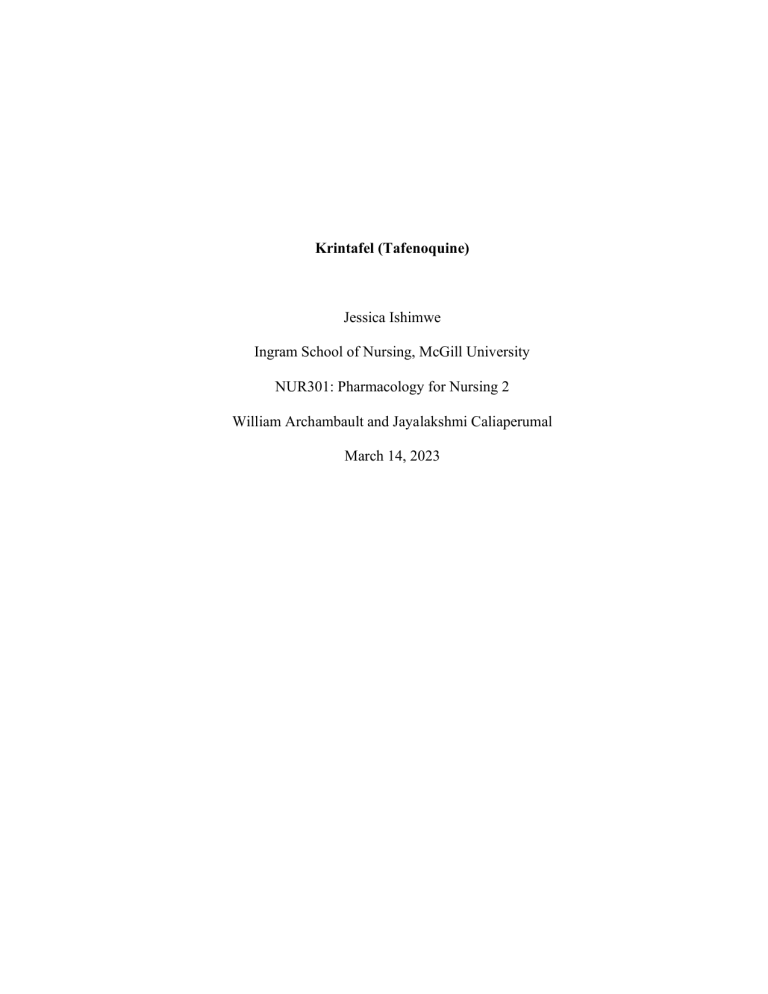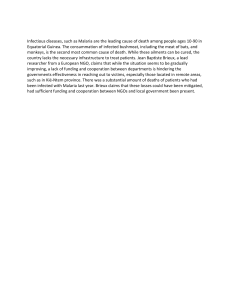
Krintafel (Tafenoquine) Jessica Ishimwe Ingram School of Nursing, McGill University NUR301: Pharmacology for Nursing 2 William Archambault and Jayalakshmi Caliaperumal March 14, 2023 DRUGS TODAY 2018/07/24 FDA approves new drug for antimalarial relapse by Shakespeare Staff Writer Krintafel tablets (MedScape, n.d.) On July 20th, the U.S. Food and Drug Administration (FDA) approved Krintafel, an antimalarial drug, to the market. This is a novel addition to the world of pharmacology and medicine, as it is the first new drug in its category in more than 60 years (Ratner, 2018). Krintafel is a "long-acting synthetic analogue" of primaquine (Ratner, 2018), an antimalarial drug which has been on the market since 1952, according to the National Academies of Sciences, Engineering, and Medicine (2020). Like primaquine, Krintafel is a part of the aminoquinoline class. Its molecular structure is the same as primaquine, with two extra methoxy groups and a 3-trifluoromethylphenoxy substitution in the quinoline ring (see the picture on the next page) (Ratner, 2018). The news of its recent approval comes after several years of clinical trials. In its first clinical trial, a doubleblind, controlled study was conducted with 522 adults positive for P. vivax. These patients received chloroquine and either a one-time dose of 300mg of Krintafel, an active control or placebo. After 6 months, patients were assessed for malaria relapse. It was found that the risk of recurrence was reduced by 76% with Krintafel and chloroquine compared to placebo and chloroquine. A second double-blind, controlled study was conducted with 111 participants, where one group received chloroquine and 300mg of Krintafel or chloroquine and placebo. The group receiving Krintafel had a recurrencefree rate of 84% after 6 months, compared to the placebo group's 39% (GSK, 2020). Malaria is a global health problem most prominent in Africa, and also occurring in Central and South America, the Caribbean, Asia, Eastern Europe and the South Pacific (CDC, 2022). This disease is caused by an infection with parasites belonging to the Plasmodium genus (P. falciparum, P. vivax, P. ovale, P. malariae and P. knowlesi). Malaria symptoms include high fever, chills, headache, nausea, vomiting, body aches, anemia, jaundice, and without treatment can lead to severe illness and death (Menkin-Smith & Winders, 2022). It was responsible for 241 million cases and 627,000 deaths worldwide in 2020 (WHO, 2021). Plasmodium falciparum and Plasmodium vivax are the two parasites most associated with malaria infections. P. falciparum accounts for more deaths while P. vivax is more widespread, and therefore results in significant numbers of cases and deaths. These parasites enter humans' bloodstream in the form of sporozoites following a bite from an infected mosquito. The sporozoites then travel to the liver and enter hepatocytes, where they form schizonts. These eventually rupture and cause Plasmodium merozoites to be released in the bloodstream, which cause the malaria symptoms listed above. P. vivax and P. ovale can release dormant hypnozoites, which can remain in the liver for months to years and cause relapse. The incubation period of malaria is 12 to 17 days, but because of these hypnozoites, relapse can occur after 2 years (Menkin-Smith & Winders, 2022). Krintafel is used to prevent relapse of P. vivax and P. ovale infections. The mechanism of action of tafenoquine (the active ingredient in Krintafel) is to act against pre-erythrocytic forms of P. vivax and ovale located in the liver as well as the parasite's asexual erythrocytic forms and gametocyte versions (i.e. the dormant forms of the parasites) (GSK, 2020). This prevents its progression into the blood and therefore stops the existing infection from developing into a severe and fatal disease (Duffy et al., 2012). There is no information yet on the molecular target of the drug (GSK, 2020). Due to its difference in structure from primaquine (the additional methoxy groups and phenoxy group), Krintafel can stay in the bloodstream longer. This provides a huge benefit in treatment adherence, as patients can complete treatment with one dose of the drug compared to the usual and difficult 14-day course of primaquine treatment (Ratner, 2018). Its halflife elimination is 15 to 16.5 days, the time to peak is 12 to 15 hours and its absorption is increased with food (Lexicomp, 2023). Adverse effects of the drug include: diarrhea, methemoglobinemia (a condition of elevated methemoglobin, where not enough oxygen is delivered to blood cells (Prchal, 2022)), headaches, back pain, epithelial keratopathy (a condition where a line or a band forms across the cornea (Singh & Tripathy, 2023)), motion sickness, nausea, vomiting, decreased hemoglobin, increased serum alanine aminotransferase and rare but serious hypersensitivity reactions. Patients should be screened for G6PD deficiency prior to treatment, as hemolytic anemia can . Chemical structures of primaquine and tafenoquine (ResearchGate, n.d.) occur in these cases. Psychiatric effects have been reported and therefore a history of psychiatric illness should be assessed before undergoing treatment, and psychiatric symptoms should be monitored. Finally, Krintafel is contraindicated in patients with hypersensitivity to tafenoquine or other 8-aminoquinolines, like primaquine (Lexicomp, 2023). "This new drug approval means so much to me," shared Jessica Ishimwe, a nursing student at McGill University. "My pharmacology course encourages me to study drugs and stay up to date with advances in medical/pharmacological research and keep up with new, interesting drugs that are hitting the market. Krintafel is a drug that piqued my interest because of how much of an impact malaria has had on my life. Being from Burundi, I am unfortunately very familiar with the disease. Every time I visit home, there are several vaccines I have to get beforehand, and once I get there, bug spray and mosquito net canopies become a lifeline. I am lucky enough to have never contracted the disease. However, over the years I have seen friends and family members travel home and end up hospitalized for weeks, fighting for their lives against malaria. Sadly, my own dad was on a trip to Burundi to work on antimalarial technologies among other entrepreneurial efforts, when he died suddenly from a co-infection with malaria and complications of Hepatitis B. The fight against malaria and other diseases common in Africa is something that will always be close to my heart, and any advances in this sector is important." Krintafel already seems like a drug that will be important in the treatment of malaria and the decrease of its transmission worldwide. It brings hope for the spur of more research and advancements in its class. Tagged: Malaria, Krintafel, Drug Discovery, Pharmaceutical Science, Burundi Word count: 971 Words. References Duffy, P. E., Sahu, T., Akue, A., Milman, N., Anderson, C. (2012). Pre-erythrocytic malaria vaccines: identifying the targets. Expert Review of Vaccines, 11(10), 1261-1280. https://doi.org/10.1586/erv.12.92 GlaxoSmithKline. (2020). Krintafel. https://www.accessdata.fda.gov/drugsatfda_docs/label/2020/210795s001lbl.pdf Lexicomp (2023). Tafenoquine: Drug information. UpToDate. Retrieved March 19, 2023, from https://www.uptodate.com/contents/tafenoquine-drug-information National Academies of Sciences, Engineering, and Medicine. (2020). Assessment of long-term health effects of antimalarial drugs when used for prophylaxis. National Academies Press. https://www.ncbi.nlm.nih.gov/books/NBK556600/ National Center for Emerging and Zoonotic Infectious Diseases. (2022, September 13). Malaria. Center for Disease Control and Prevention. https://wwwnc.cdc.gov/travel/diseases/malaria [Photograph of Chemical structures of primaquine and tafenoquine]. (n.d.). https://www.researchgate.net/figure/Chemical-structures-of-primaquine-andtafenoquine_fig1_261732761 [Photograph of Krintafel tablets]. (n.d.). https://www.medscape.com/viewarticle/899667 Prchal, J. T. (2022). Methemoglobinemia. UpToDate. Retrieved April 5, 2023, from https://www.uptodate.com/contents/methemoglobinemia Ratner, M. (2018). FDA approves first single-dose antimalarial. Nature Biotechnology, 36(785). https://doi.org/10.1038/nbt0918-785a Singh, P., Tripathy, K. (2023). Keratopathy. StatPearls Publishing. https://www.ncbi.nlm.nih.gov/books/NBK562153/ World Health Organization. (2021). World malaria report 2021. https://www.who.int/publications/i/item/9789240040496






